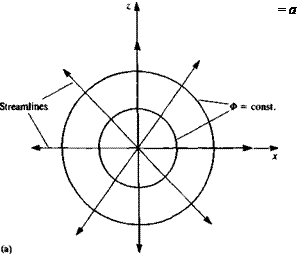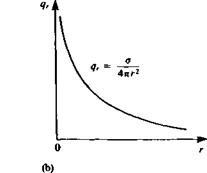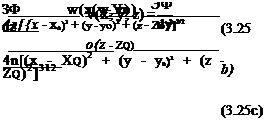BASIC SOLUTION: POINT SOURCE
One of the two basic solutions presented in Eq. (3.13) is the source/sink. The potential of such a point source element (Fig. 3.3a), placed at the origin of a spherical coordinate system, is
The velocity due to this element is obtained by using V in spherical coordinates
from Eq. (1.39). This will result in a velocity field with a radial component only,
![]()
![]() ____ о _/l a ег _ о t
____ о _/l a ег _ о t
^ 4 л r/ 4 лг2 4л r3
and, in spherical coordinates,
(‘b’qe’= (‘"dr1 °* °)= (w’0* °)
 |
So the velocity in the radial direction decays with the rate of 1/r2 and is singular at r = 0, as shown in Fig. 3.36. Consider a source element of strength a located at the origin (Fig. 3.3a). The volumetric flow rate through a spherical surface of radius r is
 FIGURE 33
FIGURE 33
(a) Streamlines and equipotential lines due to source element at the origin, as viewed in the x-z plane, (b) Radial variation of the radial velocity component induced by a point source.
where 4лг2 is the surface area of the sphere. The positive a, then, is the volumetric rate at which fluid is introduced at the source, whereas a negative a is the rate at which flow is going into the sink. Note that this introduction of fluid at the source violates the conservation of mass, therefore, this point must be excluded from the region of solution.
If the point element is located at a point r0 and not at the origin, then the corresponding potential and velocity will be
![]() 4it |r – r0|
4it |r – r0|
О Г-Го
4л |г – г„|3
The cartesian form of this equation, when the element is located at (x0, y0, A>)>
Ф^’У’ Z^ 4лІ(х – x0)2 + (y – y0)2 + (z – zof ^3’24^
The velocity components of this source element are

![]() a(x – x0)
a(x – x0)
 |
Эх 4л[{х – Xq)2 + (у – уо) + (z – zb)2]3
This basic point element can be integrated over a line l, a surface S or a volume V to create corresponding singularity elements that can be used, for example, to construct panel elements. Consequently, these elements can be established by the following integrals:
![]()
![]() <4*0, УО, Zq) dl
<4*0, УО, Zq) dl
V(* – x0) + (у – Уо) + (z – Zof
<4*o, Уо, Zq) dS
V(* – *0)2 + (y – Уо)2 + (z – z0)2
a(x0, y0, Zq) dV
V(x – Xq)2 + (y – y0)2 + (z – Zq)2
Note that a in Eqs. (3.26), (3.27), and (3.28) represents the source strength per unit length, area, and volume, respectively. The velocity components induced by these distributions can be obtained by differentiating the corresponding potentials:











